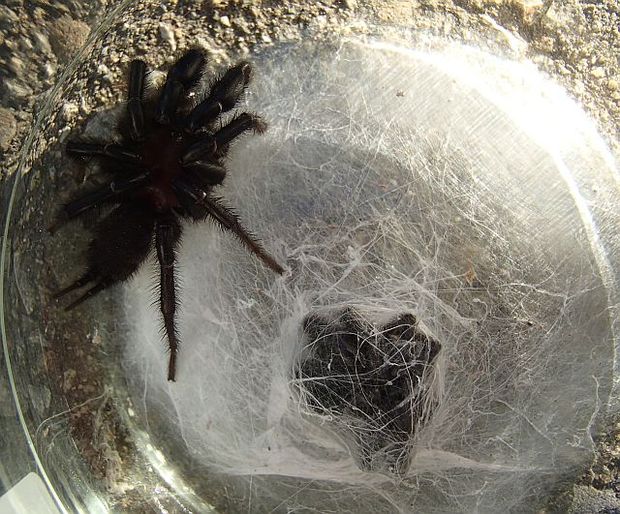
The black tunnelweb spider Porrhothele antipodiana is a familiar native resident in gardens around New Zealand, and well known for wandering into houses. Ths spider has set up residence in an empty glass jar in a garage, and has killed another spider which it has wrapped up in silk (image: A. Ballance)
‘Most spiders around the house are introduced, so if you look for spiders around the house you get a very skewed idea of spider diversity in New Zealand’.
That comment comes from Canterbury Museum spider expert Cor Vink, who says there are an estimated 2000 species of spider in New Zealand, of which just 70 are introduced species. Ninety three percent of New Zealand’s native species are endemic, or found only here, and live in forest and other native habitats.
When Alison Ballance made a house call recently to see what kind of spiders live in a spider expert’s house she discovered that a wet winter’s day is the worst time to choose for a spider hunt. ‘Most spiders are active at night’ says Cor Vink, ‘And many spiders overwinter as eggs or juveniles, and the adults die.’ However there was plenty of evidence of spiders, such as cobwebs left by cellar spiders, which is the name Cor Vink prefers to use for a common household spider that many people call daddy longlegs.
‘Cellar spiders are a useful spider’ says Cor Vink as they will ‘take on anything, including white-tailed spiders, which specialise in eating other spiders.’ The cellar spider has long legs, which make it difficult for the white-tailed spider to bite where its front leg joins the body, and also the cellar spider hunts by throwing silk over its prey, and is able to immobilise and then kill a white-tailed spider.
The white-tailed spider’s preferred prey is the grey house spider, another introduced species from Australia, which Cor describes as a ‘lazy spider’ that reuses empty webs. While white-tailed spiders inflict a painful bite which can cause local swelling, Cor Vink points out that there is no credible scientific or medical evidence linking white-tailed spider bites with necrotising wounds.
Cor explains that most spiders have quite poor vision. ‘Your average spider can see as well as you or I with a pillowcase on our head. But househoppers can see 30 centimetres away.’ Househoppers are small jumping spiders from Australia, and like all hunting spiders have very good vision.
Other spider evidence that Cor found in his house and garage was an orb spider egg sac, well wrapped in dark grey silk, and a thick horizontal sheet in a corner built by a European sheetweb spider.
This Our Changing World story features Ximena Nelson from Canterbury University and her research into the vision of jumping spiders.
HOUSE SPIDERS AUDIO

